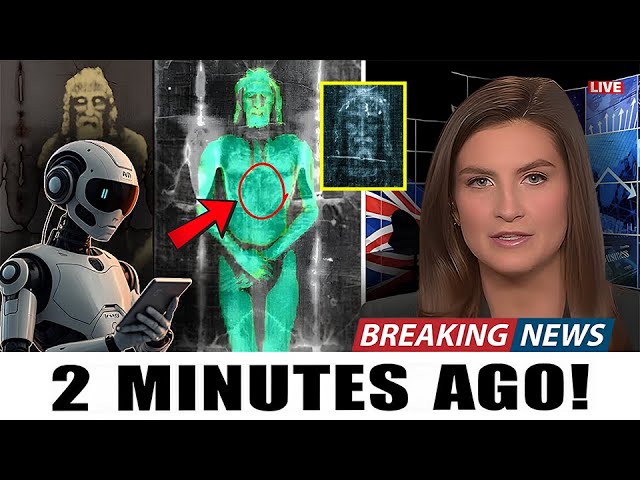AI Analyzes the Shroud of Turin – And What It Revealed Stunned Everyone!

An image unlike any other – the Shroud of Turin. A simple strip of ancient cloth, yet it has inspired decades of research, debate, and an unrelenting desire for answers. For those who believe, it represents the final sacred trace—because Jesus left behind no writings, no physical belongings, and no confirmed archaeological evidence of His existence. And now, a new chapter unfolds: artificial intelligence has been deployed to analyze the mysterious image on the cloth—and what it uncovered has sent shockwaves through both the scientific and religious worlds.
For centuries, the Shroud has baffled scholars, theologians, and skeptics alike. Could it truly be the burial cloth of Jesus Christ? Earlier investigations only raised more questions. But now, AI may have discovered a key clue. What it revealed left researchers speechless—and it may forever change how we view one of Christianity’s most sacred relics.
The image on the Shroud defies explanation. Is it a positive or a negative? Created by pressure—or by light? Could it even hint at something beyond death—perhaps a sign of resurrection itself?
The Shroud isn’t made of gold. It isn’t adorned with jewels. And it isn’t pristine. It’s simply a 14-foot strip of linen bearing the faint imprint of a naked, wounded man—seemingly crucified. And yet, for over 600 years, this modest piece of cloth has captured the faith of millions. It first appeared in recorded history in the 14th century, in the small town of Lirey, France. No lightning bolts. No ancient scrolls. A local knight quietly claimed it was the true burial cloth of Christ. The Church remained cautious and never officially confirmed it.
The first turning point came in 1898, when an amateur photographer took the first known photo of the Shroud—and something astonishing happened: the photographic negative revealed a clearer, more defined image than the cloth itself. A face, a body, wounds—all suddenly visible in striking detail. There were no brushstrokes, no paint, no ink. Some scientists theorized that the image might have been caused by a burst of energy—possibly radiation—strong enough to imprint a body onto the cloth without burning it.
Then, in 1988, three prestigious laboratories—Zurich, Oxford, and Arizona—used carbon-14 testing on samples of the Shroud. Their results seemed decisive: the cloth dated between 1260 and 1390 AD. For many, the case was closed.
But not long after, doubts began to surface. Some experts argued that the tested area had been repaired with newer threads after fire damage. If true, that could have skewed the carbon dating. And just like that, the mystery returned.
The 21st century brought more advanced tools. In 2022, Italian researchers used a method called Wide-Angle X-ray Scattering (WAXS) to measure how the linen’s fibers had aged. The results were astonishing: the cloth could date back to between 55 and 74 AD—right after the crucifixion of Jesus. Isotope analysis of the flax used to weave the cloth pointed to the Levant—modern-day Israel—not Europe. The blood on the Shroud? Human, type AB—rare, but real. The wounds matched the Gospel descriptions: pierced wrists, bleeding scalp, lash marks, a wound in the side—details that surpass what medieval art depicted.
Still, controversy persists. The mainstream scientific community remains cautious. But the question has shifted. It’s no longer “Was it faked?”—but rather, “If it wasn’t… then what is it?”
That’s when AI entered the picture.
An artist fed high-resolution scans of the Shroud into the AI tool Midjourney, asking it to reconstruct the man behind the markings. The result stunned viewers: a rugged Middle Eastern face, bloodied brow, deep-set eyes, a calm but haunting expression. This wasn’t the European Jesus of art history—it looked like a real man from the 1st century.
Next, people pushed the AI further—asking it to imagine how the image was formed. It generated scenes of radiant light, with the body hovering above the cloth instead of pressing into it. Light beams replaced bloodstains. The face remained calm—not lifeless, not in agony, just… still. The visuals spread quickly. Captions read: “Is this what resurrection looks like?” AI doesn’t believe—but maybe it visualized a miracle.
The critics responded: Midjourney is trained on millions of images, including religious art. The outputs reflect cultural biases. And they’re right—to a point. But here’s the twist: the visual cues weren’t from art. They were from the cloth itself. A centuries-old artifact that science still cannot explain.
The AI didn’t just render a face. It suggested a deeper story—of suffering, of mystery, and perhaps, of something more. No one claims AI proved the resurrection. But more people now admit the Shroud is far more complex than previously thought. As one researcher said, “If this is a forgery, it’s the most advanced image encoding in human history—and we still don’t know how it was done.”
At the Vatican-endorsed 2025 digital exhibition in Turin, crowds quietly observed a high-resolution display of the Shroud. The AI version wasn’t officially shown—but it was there, on people’s phones, in their minds, and in the whispers of those staring into the face that still captivates the world.
This wasn’t just about proving a resurrection or exposing a hoax. It became something deeper: a search for meaning. AI didn’t solve the mystery—it deepened it. Headlines read: “AI Decodes the Shroud—and Shocks the World.” But not with answers. With possibility.
What if the Shroud is both artifact and miracle? Both science and symbol?
The cloth itself hasn’t changed. It remains silent. But the conversation has shifted. Whether it’s a divine relic or an ancient masterpiece, one haunting question still echoes:
What really happened in that tomb?
And did this cloth capture the moment when everything changed?
After all this time—and all our technology—maybe the real mystery is why we still don’t know.







